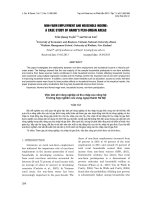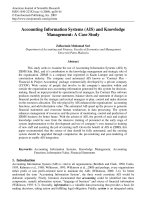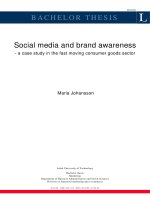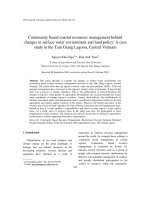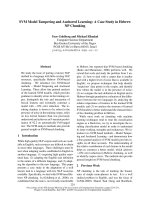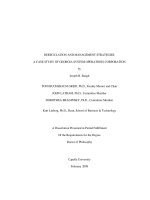be to and have to + lexical verbs and their modal meanings from functional and cognitive perspectives (a case study based on lifelines textbooks used in hanoi pedagogical university no 2 tt
Bạn đang xem bản rút gọn của tài liệu. Xem và tải ngay bản đầy đủ của tài liệu tại đây (223.13 KB, 6 trang )
1
VIETNAM NATIONAL UNIVERSITY, HANOI
UNIVERSITY OF LANGUAGES AND INTERNATIONAL STUDIES
FACULTY OF POST-GRADUATE STUDIES
MAI THI
̣
VÂN ANH
“BE TO” AND “HAVE TO” + LEXICAL VERBS AND THEIR MODAL
MEANINGS FROM FUNCTIONAL AND COGNITIVE PERSPECTIVES
(A CASE STUDY BASED ON LIFELINES TEXTBOOKS USED IN
HANOI PEDAGOGICAL UNIVERSITY NO 2)
CÂ
́
U TRU
́
C “BE TO” VA
̀
“HAVE TO” + ĐNG T CHNH V NGHA TNH THI
CA CHNG NHN T GC Đ NGÔN NG HC CHC NĂNG V TRI NHN
(1 NGHIÊN CƯ
́
U CU
̣
THÊ
̉
DƯ
̣
A TRÊN GIA
́
O TRI
̀
NH “LIFELINES” ĐƯƠ
̣
C GIA
̉
NG
DY TI TRƯNG ĐI HC SƯ PHM H NI 2)
M.A MINOR THESIS
Field: English Linguistics
Code: 60 22 15
HANOI, 2010
2
VIETNAM NATIONAL UNIVERSITY, HANOI
UNIVERSITY OF LANGUAGES AND INTERNATIONAL STUDIES
FACULTY OF POSTGRADUATE STUDIES
MAI THI
̣
VÂN ANH
“BE TO” AND “HAVE TO” + LEXICAL VERBS AND THEIR MODAL
MEANINGS FROM FUNCTIONAL AND COGNITIVE
PERSPECTIVES (A CASE STUDY BASED ON LIFELINES
TEXTBOOKS USED IN HANOI PEDAGOGICAL UNIVERSITY NO 2)
CÂ
́
U TRU
́
C “BE TO” VA
̀
“HAVE TO” + ĐNG T CHNH V NGHA TNH THI
CA CHNG NHN T GC Đ NGÔN NG HC CHC NĂNG V TRI NHN
(1 NGHIÊN CƯ
́
U CU
̣
THÊ
̉
DƯ
̣
A TRÊN GIA
́
O TRI
̀
NH “LIFELINES” ĐƯƠ
̣
C GIA
̉
NG
DY TI TRƯNG ĐI HC SƯ PHM H NI 2)
M.A MINOR THESIS
Field: English Linguistics
Code: 60 22 15
Supervisor: Assoc. Prof. Dr. Trâ
̀
n Hư
̃
u Ma
̣
nh
HANOI, 2010
6
LIST OF TABLES
Table 1: Values in modality.
Table 2: Modality and Modulation
Table 3: Semi- modality distinction.
Table 4: The auxiliary verb- main verb gradient
Table 5: Variant forms of the lexical verb be.
Table 6: Variant forms of have.
Table 7: The result of the achieved test
7
TABLE OF CONTENTS
Page
DECLARATION……………………………………………………………………
i
ACKNOWLEDEGMENTS…………………………………………………………
ii
ABSTRACT……………………………………………………………………………
iii
LIST OF TABLES……………………………………………………………………
iv
PART A: INTRODUCTION
1
1. Rationale of the study
1
1.1 Literature review
1
1.2. Rationale
2
2. Aims of the study
3
2.1. Objectives
3
2.2. Research questions
3
3. Scope of the study…………………………………………………………………….
4
4. Methodology………………………………………………………………………….
4
5. Design of the study…………………………………………………………………
4
PART B: DEVELOPMENT
5
CHAPTER 1: THEORETICAL BACKGROUND
5
1.1. Theory of Grammar
5
1.1.1. Definitions
5
1.1.2. Schools of grammar
5
1.1.2.1. Functional Grammar
5
1.1.2.2. Halliday‟s Functional Grammar
6
1.1.2.3. Cognitive Grammar
6
1.2. Concept of modality and semi- modality in English
7
1.2.1. Definition of modality
7
1.2.2 Types of modality
7
1.2.2.1. Deontic modality
8
1.2.2.2. Epistemic modality
9
1.2.2.3. Types of modality in Halliday‟s view
9
8
1.2.2.4. A cognitive approach to modality
11
1.2.2.5. Summary
13
1.2.3. Concept of semi-modality
13
1.3. Modal and semi- modal verbs in English…………………………………………
15
1.3.1. Concepts of modal and semi- modal verbs
15
1.3.1.1. Definition of modal verbs
15
1.3.1.2. Definition of semi-modal verbs
15
1.3.2. Morphological, syntactic and semantic features of modal verbs
16
1.3.2.1. Morphological, syntactic features of modal verbs
16
1.3.2.2. Semantic features of modal verbs
17
1.3.3. Morphological, syntactic (inflectional) and semantic features of semi- modals
18
1.3.3.1. Morphological, syntactic (inflectional) features of semi- modals
18
1.3.3.2. Semantic features of semi- modals
20
1.3.4. Summary
21
CHAPTER 2: INVESTIGATION
22
2.1. Features of modal meanings expressed by „be to‟ and „have to‟
22
2.1.1. Conventional meanings of „be to”
22
2.1.2. Conventional meanings of “have to”
23
2.1.3. „Be to‟, „have to‟ and the semantic blend between Epistemic and Deontic
modality
25
2.1.4. Summary
26
2.1.5. Inflection of „be‟ in present, past, progressive and perfect tense
27
2.1.5.1. Be- as an auxiliary
28
2.1.5.1.1. Be- in forming the progressive
28
2.1.5.1.2. Be- in forming the passive
29
2.1.5.2. Be – a lexical verb / full verb
29
2.1.5.2.1. Be with the perfect aspect
29
2.1.5.2.2. Be with the Progressive Aspect
30
2.2.1. Inflection of „have‟ in present, past, perfect and progressive tense
31
2.3. Structures containing “be to” and “have to” + verb
32
2.3.1. Structures containing „be to‟+ verb
32
9
2.3.1.1. „Be due to‟+ verb
32
2.3.1.2. „Be about to+ verb‟ and „be on the point of + V-ing‟
32
2.3.1.3. „Be able to‟+ verb
33
2.3.1.4. „Be going to‟+ verb
33
2.3.1.5. „Be meant to‟ and „be supposed to‟+ verb
33
2.3.1.6. „Be bound to‟ and „be supposed to‟+ verb
33
2.3.2. Structures containing “have to” + verb
34
2.3.3. Summary
34
CHAPTER 3- INVESTIGATION AND FINDINGS
35
3.1. Test design
35
3.1.1. Description of syllabus and textbook
35
3.1.2. Objectives of the test
35
3.1.3. Format of the test
35
3.2. Test implementation
36
3.3. Test result and errors made by learners
36
3.4. Application to the teaching and learning modals and semi- modals
38
3.4.1. Frequencies of Vietnamese students‟ errors in using modals and semi- modals
38
3.4.2. The causes to Vietnamese students‟ errors
39
3.4.3. Solutions to the problems
39
PART C: CONCLUSION AND IMPLICATION
41
1. Conclusions
41
2. Implications of the study for teaching English modals and semi-modals
41
3. Limitations of the study
42
4. Suggestions for further research
42
REFERENCES
43
APPENDIX
I
